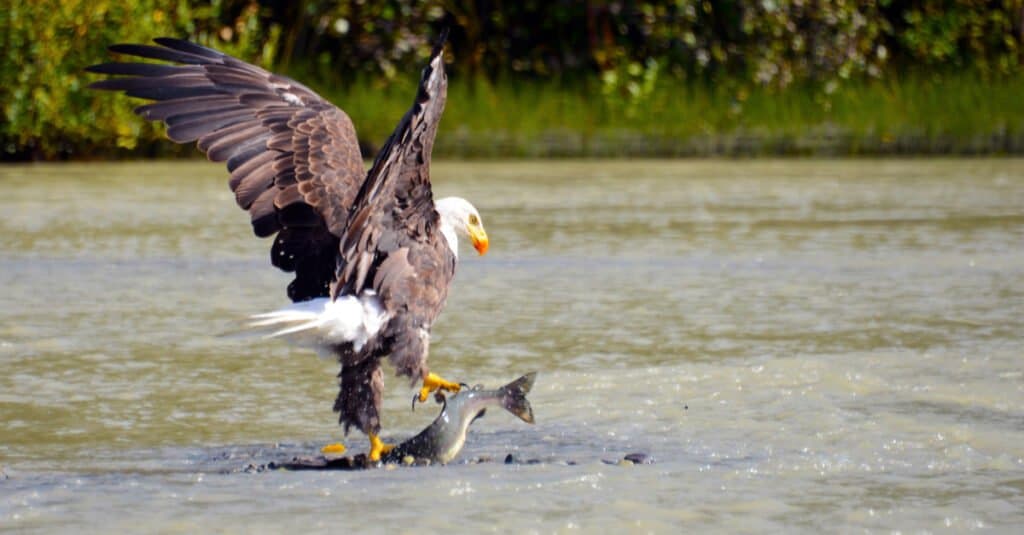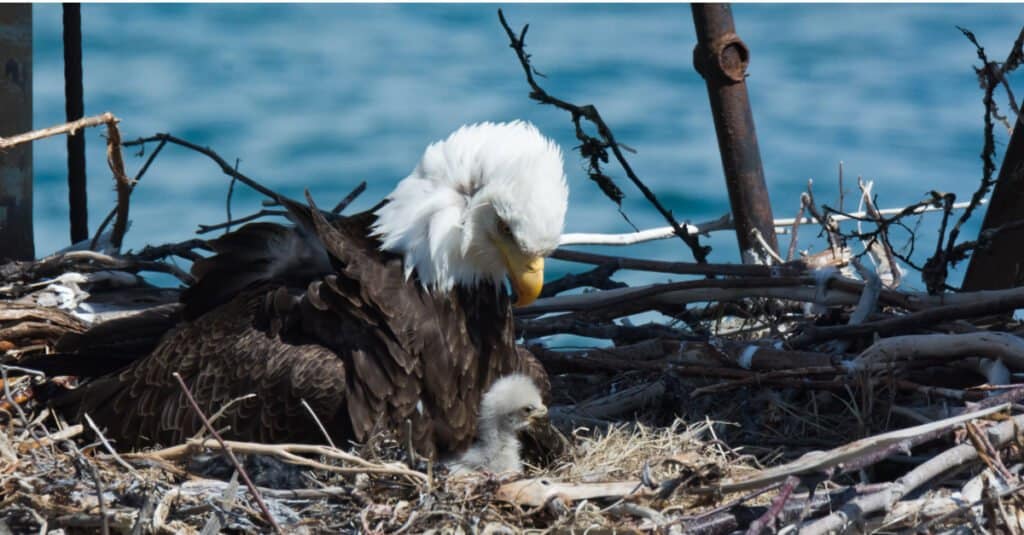The bald eagle is the iconic symbol of the United States, having been the national bird since 1782. However, it is also a symbol of resilience and recovery. The bald eagle population once declined so drastically that they were at serious risk of becoming extinct. Thankfully, a combination of factors allowed these magnificent birds the chance to fight back from the brink and thrive once again. So, keep reading to discover exactly how the bald eagle escaped extinction!
Why Did the Bald Eagle Population Decline?

Bald eagles originally thrived before they became almost extinct in the 1960s.
©PHOTOOBJECT/Shutterstock.com
The bald eagle originally had a thriving population, and they were widespread across the majority of the country. In fact, it is estimated that there were approximately 100,000 nesting birds at the time that they were adopted as the national bird. However, by the late 1800’s, the population began to decline quite drastically. By 1940, bald eagles were considered to be “threatened with extinction”, and by the 1960s, there were only around 400 breeding pairs of bald eagles remaining in the country. This put the species at even greater risk of extinction.
There are several reasons why the bald eagle population has declined so much and so quickly. The first reason is habitat destruction. Bald eagles typically nest close to bodies of water, such as along coastlines or close to rivers. They build their nests in large trees, and their nests are typically five to six feet wide and as much as three feet deep. However, in some cases they can be significantly larger, with the largest on record being 10 feet wide and 20 feet high. As such, deforestation for logging and building new houses and towns destroyed large areas of their nesting habitats.
Hunting was another threat that bald eagles faced. Despite preying mainly on fish, many people viewed bald eagles as a pest as they thought that they posed a threat to farm animals such as chickens and lambs. As a result, bald eagles were often purposely shot in many areas in an effort to eliminate them.
Pesticides
The greatest factor that contributed to the decline of bald eagles was the use of pesticides — particularly DDT. DDT began to be used widely after World War II, but it entered watercourses when it ran off into them. It was then absorbed by fish and other aquatic animals, effectively contaminating the bald eagle’s prey. The bald eagles ate the animals that now contained the DDT and were themselves poisoned by it.
The pesticide didn’t directly kill the eagles, but instead it affected their eggs. The chemicals in the pesticide caused the egg shells to be much thinner than usual. This meant that the eggs didn’t hatch as they were weak and easily broken during the incubation period. The lack of chicks meant that the population was unable to be maintained at its previous level and it went into a steep decline.
How the Bald Eagle Recovered

The ban of DDT meant that the pesticide was no longer entering the food chain.
©jbieger/Shutterstock.com
The mid-1960’s were a dire time for bald eagles, but in 1962, the problems caused by DDT began to be identified and exposed. However, the use of the pesticide was not actually banned until 1972. The ban meant that the toxic chemicals were no longer entering the food chain and poisoning the bald eagles, but the effects on the population still lasted for years to come.
Bald eagles were officially listed as an endangered species in 1978 across the contiguous United States, although they were only classified as “threatened” in Michigan, Minnesota, Oregon, Washington, and Wisconsin, where their numbers were slightly stronger. The categorization of bald eagles as an endangered species meant that they had much more protection than they had previously. It meant that they could no longer be hunted, and their nests across large parts of their range could be protected.
Furthermore, by classifying bald eagles as endangered, conservationists were able to implement breeding programmes. They were also able to take steps to reintroduce bald eagles into the areas where they had become locally extinct, allowing populations to recover.
Bald Eagles Today

After a period as an endangered species, bald eagles are once again thriving.
©Jon C. Beverly/Shutterstock.com
After many years of hard work and careful management, in 1995 bald eagles were downgraded to “threatened” across the rest of the US, where they had previously been classified as “endangered”. The population continued to recover, and in 2007, the bald eagle was removed from the endangered species list entirely.
Bald eagles have made a remarkable recovery from the brink of extinction, and today there are estimated to be more than 71,000 breeding pairs of bald eagles across the contiguous United States. In total, it is estimated that the population contains more than 300,000 birds. With a story like this, it is no wonder that the bald eagle continues to be a proud symbol of strength.
The photo featured at the top of this post is © FloridaStock/Shutterstock.com
Thank you for reading! Have some feedback for us? Contact the AZ Animals editorial team.






